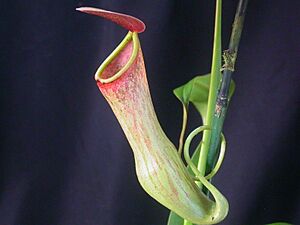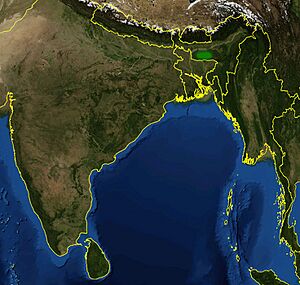Nepenthes khasiana facts for kids
Quick facts for kids Nepenthes khasiana |
|
|---|---|
 |
|
| Nepenthes khasiana. Cultivated plant. | |
| Conservation status | |
| Scientific classification | |
| Genus: |
Nepenthes
|
| Species: |
khasiana
|
 |
|
| Satellite image of the Indian subcontinent with the distribution of N. khasiana highlighted in green. | |
The Nepenthes khasiana is a special kind of plant. It is a tropical pitcher plant that is found mostly in the Khasi Hills of India. This plant is the only Nepenthes species that grows naturally in India. Scientists think it attracts insects by glowing with a blue light!
Contents
About the Khasi Pitcher Plant
This amazing plant is known for its unique "pitchers." These are like cups that hang from the leaves. They are filled with a liquid that helps the plant catch and digest insects. This is how the pitcher plant gets its nutrients, especially in poor soil.
Where It Lives
The N. khasiana plant is quite rare in the wild. It grows in only a few specific places. These include parts of the Jaintia Hills, Garo Hills, and Khasi Hills in Meghalaya. It can also be found in the Dima Hasao district of Assam and some areas of Nagaland. Even though it's rare, the plants found in these different areas show a lot of variety in their genes.
Today, thanks to new farming methods, this pitcher plant is also grown in places like Nagaland University. You can even see them as decorative plants outside many homes in Nagaland.
Local Names for the Plant
Different groups of people in India have special names for the Nepenthes khasiana:
- The Khasi people call it tiew-rakot. This means "demon-flower" or "devouring-plant."
- The Jaintias call it kset phare. This roughly translates to "lidded fly net."
- The Garo people call it memang-koksi. This means "the basket of the devil."
- The Biate tribe in Assam calls it Jug-Par, meaning "Jug-flower," or Loisul Kola, which means "Pitcher-plant."
Protecting This Plant
The Nepenthes khasiana is an endangered species. This means it is at high risk of disappearing forever. It is protected by a global agreement called CITES Appendix I. This rule means that people are not allowed to buy or sell these plants across countries for business.
There are several reasons why this plant is in danger:
- Habitat loss: Its natural homes are being destroyed.
- Mining: Pollution from coal mining can harm the plant's environment.
- Collection: Some people collect the plants from the wild for medicine or to sell as decorations.
To help save this plant, a special project called the Rare Nepenthes Collection was started in 2010. This project aims to protect four of the most endangered Nepenthes species, including N. khasiana.
Plant's Name History
The scientific name khasiana comes from the Khasi Hills where it mainly grows. You might see the name spelled khasyana in some older books. This spelling was actually used before the plant was officially described in 1873 by Joseph Dalton Hooker. For a while in the late 1800s, people sometimes confused N. khasiana with another pitcher plant called Nepenthes distillatoria, which comes from Sri Lanka.
Images for kids






